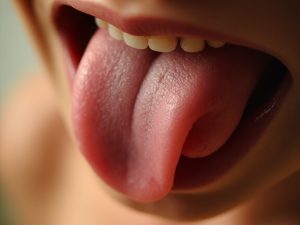Table of Contents
TogglePrecautions for Tongue Diagnosis in Traditional Chinese Medicine
Author: Gu Yuxi Editor: Gu Yuxi Translator: Gu Yuxi
Precautions for Tongue Diagnosis
To ensure the accuracy of the information obtained from tongue diagnosis, it is essential to eliminate false tongue appearances caused by various operational factors. The following points should be noted when observing the tongue:
1. Influence of Light
The intensity and tone of light have a significant impact on color perception, often causing observers to have different sensations of the same color. Slight negligence can easily lead to illusions. As stated in A Guide to Tongue Diagnosis: ‘Yellow coating viewed under lamplight often appears white. Thus, while the tongue can be relied upon, it cannot be entirely relied upon. Without careful examination, misdiagnosis is difficult to avoid.’ Observing the tongue is best done under ample and soft natural daylight. If at night or in a dim place, white fluorescent light is preferable, and the light should directly illuminate the tongue surface, avoiding the influence of colored light sources on the tongue’s color.
2. Influence of Diet or Medication
The intake of food and drugs can cause changes in the tongue appearance. For example, after eating, due to the repeated friction of food, a thick tongue coating can become thin; after drinking water, a dry tongue coating can become moist. Overly cold or hot food and irritating foods can change the tongue color. For instance, immediately after eating spicy and hot food, the tongue color can change from light red to bright red, or from red to crimson. Long-term use of certain antibiotics can produce a black greasy coating or a cheesy coating.
Certain foods or drugs can stain the tongue coating, which is called stained coating. For example, drinking milk, soy milk, barium sulfate, coconut milk, etc., can make the tongue coating appear white and thick; eating foods rich in fat such as peanuts, melon seeds, beans, walnuts, and almonds often causes yellowish-white residue to adhere to the tongue surface in a short time, which is easily confused with a slimy greasy coating; eating egg yolks, oranges, persimmons, riboflavin, etc., can stain the tongue coating yellow; various dark brown foods, drugs, or eating olives, preserved plums, and long-term smoking can stain the tongue coating gray or black.
Generally, stained coatings will naturally disappear within a short time or can be removed by wiping the tongue. They usually do not adhere evenly to the tongue surface and do not correspond with the patient’s condition. If there is any doubt, inquire about diet, medication, etc., for differentiation, and be careful not to misjudge.
3. Influence of the Oral Cavity on Tongue Appearance
Missing teeth can cause the tongue coating on the same side to appear thicker; dentures or irregular gums can leave teeth marks on the tongue edges; mouth breathing during sleep can lead to a thickened and dry tongue coating. These tongue abnormalities caused by such factors should not be considered pathological signs. Careful differentiation is necessary in clinical practice to avoid misdiagnosis.
4. Influence of Tongue Protrusion Posture
When protruding the tongue, if the tongue body curls up, or if excessive force is used, or if the tongue is extended for too long, it can affect blood circulation in the tongue, leading to changes in tongue color, or cause the tongue coating to become compact and altered, or change the moisture level of the tongue coating.
— Excerpt from Li Candong’s Diagnostics of Traditional Chinese Medicine
My Annotations and Analysis:
Essential Points for Tongue Diagnosis Practice (Simplified Learning Edition)
Summary of Precautions for Tongue Diagnosis
One. Influence of Light
Core Points: Avoid light source interference to ensure accurate tongue color identification.
Specific Requirements:
- Prioritize natural daylight, ensuring soft and even illumination.
- Use white fluorescent light at night or in dim areas, avoiding colored light sources.
- Direct the light source onto the tongue surface, avoiding shadow interference.
Classical Reference: A Guide to Tongue Diagnosis points out that yellow coating under lamplight is easily misjudged as white coating, requiring careful differentiation.
Two. Influence of Diet and Medication
Types of Interference:
1. Physical Friction: Tongue coating thins after eating; moisture level changes after drinking water.
2. Temperature Stimulation: Overly cold/hot food may temporarily redden or crimson the tongue color.
3. Staining Effect (Stained Coating):
* White: Milk, soy milk, barium sulfate
* Yellowish-white residue: Fatty foods like peanuts, melon seeds, walnuts
* Yellow: Oranges, persimmons, riboflavin
* Gray-black: Olives, preserved plums, smoking, or certain medications.
Methods of Differentiation:
Stained coatings usually exist for a short time and can be removed by wiping the tongue.
Inquire about the patient’s recent dietary and medication history.
Three. Interference from Oral Cavity Factors
Common Issues:
1. Missing teeth: Thickened tongue coating on the same side.
2. Dentures or uneven gums: Teeth marks on the tongue edges.
3. Mouth breathing: Dry and thickened tongue coating.
Recommendations for Handling:
Evaluate pathological significance after excluding physiological interference.
Make a comprehensive judgment in conjunction with oral examination.
Four. Standard Tongue Protrusion Posture
Incorrect Practices:
1. Curling up the tongue or using excessive force.
2. Protruding the tongue for too long (>30 seconds).
Consequences:
Tongue color becomes distorted due to changes in blood flow.
Abnormal moisture level and compactness of the tongue coating.
Correct Method:
Extend naturally and relax, with the tip of the tongue lightly touching the lower lip.
Observe quickly (complete within 5-10 seconds).
Disclaimer:
The experiences and insights shared above represent the author’s personal usage and understanding, and are provided for reference only as part of academic exchange. Please do not blindly replicate or apply them; any consequences arising from such actions are solely your responsibility. As individual constitutions vary, medication should be tailored accordingly. It is advisable to use such treatments under the guidance of a qualified physician. If you have additional experiences to share, comments and submissions are welcome.
If you appreciate my article, please give it a like.
If you are a generous and affluent individual, please consider making a donation!
Your recognition is my greatest motivation to continue writing—thank you very much!
USD Donation Button —
A RMB donation button is available below.
 微信赞赏
微信赞赏 支付宝赞赏
支付宝赞赏




